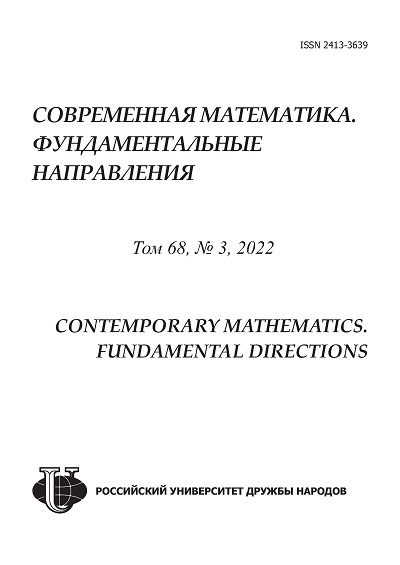Vol 68, No 3 (2022): Proceedings of the Crimean Autumn Mathematical School-Symposium
- Year: 2022
- Articles: 8
- URL: https://journals.rudn.ru/CMFD/issue/view/1571
- DOI: https://doi.org/10.22363/2413-3639-2022-68-3
Full Issue
Articles
On Spaces of Vector Functions that Are Holomorphic in an Angular Domain
Abstract
In this paper, we study spaces of vector functions that are holomorphic in the angular domain of the complex plane and with values in a separable Hilbert space. We show that, equipped with the appropriate norms, these spaces are Hilbert spaces.
 393-406
393-406


Order Projection in OAr(E,F)
Abstract
We investigate order projections onto different bands in the space of all regular orthogonally additive operators. In particular, we obtain formulas for calculation of the order projections onto the band generated by a directed set of positive orthogonally additive operators and onto the band of all laterally continuous operators.
 407-423
407-423


Chaos in Topological Foliations
Abstract
We call a foliation (M,F) on a manifold M chaotic if it is topologically transitive and the union of closed leaves is dense in M. A foliated manifold M is not assumed to be compact. The chaotic foliations can be considered as multidimensional generalization of chaotic dynamical systems in the sense of Devaney. For foliations covered by fibrations we prove that a foliation is chaotic if and only if its global holonomy group is chaotic. We introduce the concept of the integrable Ehresmann connection for a foliation as a natural generalization of the integrable Ehresmann connection for smooth foliations. A description of the global structure of foliations with integrable Ehresmann connection and a criterion for the chaotic behavior of such foliations are obtained. Applying the method of suspension, a new countable family of pairwise nonisomorphic chaotic foliations of codimension two on 3-dimensional closed and nonclosed manifolds is constructed.
 424-450
424-450


Asymptotic Behavior of Solutions of a Complete Second-Order Integro-Differential Equation
Abstract
In this paper, we study a complete second-order integro-differential operator equation in a Hilbert space. The difference-type kernel of an integral perturbation is a holomorphic semigroup bordered by unbounded operators. The asymptotic behavior of solutions of this equation is studied. Asymptotic formulas for solutions are proved in the case when the right-hand side is close to an almost periodic function. The obtained formulas are applied to the study of the problem of forced longitudinal vibrations of a viscoelastic rod with Kelvin-Voigt friction.
 451-466
451-466


Topological Conjugacy of Gradient-Like Flows on Surfaces and Efficient Algorithms for Its Distinguition
Abstract
Gradient-like flows on surfaces have simple dynamics, which inspired many mathematicians to search for invariants of their topological equivalence. Under assumptions of different generality on the class of gradient-like flows under consideration, such classical invariants as the Leontovich- Mayer scheme, the Peixoto graph, the equipped Peixoto graph, the two-color Wang graph, the threecolor Oshemkov-Sharko graph, the Fleitas circular scheme, etc. were obtained. Thus, the problem of classifying gradient-like flows on surfaces from the point of view of topological equivalence has been solved in an exhaustive way. In recent works by Kruglov, Malyshev, and Pochinka, it was proved that for gradient-like flows the topological equivalence classes coincide with the topological conjugacy classes. The obtained result allows us to use any invariants of their equivalence for topological conjugacy of gradient-like flows. The present study is a review of the results on topological conjugacy of gradient-like flows on surfaces and efficient algorithms for its distinguishing, that is, algorithms whose running time is limited by some polynomial on the length of the input information.
 467-487
467-487


 488-508
488-508


Multistability for a Mathematical Model of the Dynamics of Predators and Preys in a Heterogeneous Area
Abstract
We consider the system of reaction-diffusion-advection equations describing the evolution of the spatial distributions of two populations of predators and two prey populations. This model allows us to consider directed migration, the Holling functional response of the second kind, and the hyperbolic prey growth function. We obtain conditions on the parameters under which cosymmetries exist. As a result, multistability is realized, i.e., the one- and two-parameter families of stationary solutions appear. For a homogeneous environment, we analytically derive explicit formulas for equilibria. With a heterogeneous habitat, we computed distributions of species using the method of lines and the scheme of staggered grids. We present the results of violation of cosymmetry and transformation of the family in the case of invasion of a predator.
 509-521
509-521


Models of Self-Adjoint and Unitary Operators in Pontryagin Spaces
Abstract
This paper represents a revised version of the lectures, delivered by the author at KROMSH-2019. These lectures are devoted to describing a few different ways of constructing a model representation for self-adjoint and unitary operators acting in Pontryagin spaces, and a comparison between them. Two of these models are based on the regularized integral Krein-Langer representation of a numerical sequence generated by the powers of a self-adjoint (in the sense of Pontryagin spaces) operator. The steps to deduce both this representation and the spectral function of the corresponding operator are given. In both models (first of which belongs to the author of this paper), the operator is realized as an operator of multiplication by an independent variable, but the space of functions in which it acts is different for each of the models. The third model, introduced by V. S. Shulman, is based on his own concept of a quasi-vector.
 522-552
522-552












